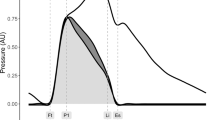Abstract
Impedance measurements have been used to quantify changes in vascular function associated with hypertension. Fourier analysis based solely on the arterial flow wave may provide a useful alternative to traditional techniques. Therefore the utility of blood flow frequency analysis in differentiating vascular changes in hypertension is tested. A frequency-based method was developed to evaluate the aortic pulse wave under conditions of spontaneous hypertension, sodium nitroprusside (SNP) induced normotension in spontaneously hypertensive rats (SHR), and phenylephrine (PE) induced hypertension in Wistar–Kyoto rats (WKY). Under anesthesia, animals were instrumented and signals were digitized for measurement of arterial blood pressure, aortic blood flow, and electrocardiogram. Hemodynamic parameters were extracted and the aortic flow signal was processed via Fourier analysis to produce a fingerprint of pulse transmission. Results demonstrated significant fingerprint differences between SHR and WKY at baseline pressures. Fingerprint differences are simulated by PE-induced hypertension, however, they did not match the SHR fingerprint despite similar flow-based biomarkers. Conversely, administration of SNP to the SHR creates differences in the fingerprint, however, SNP did not approximate the WKY fingerprint despite similar hemodynamics. Furthermore, characteristic fingerprint differences between SHR and WKY vasculature are maintained regardless of the intervention. In conclusion, results suggest Fourier analysis can be used to reveal functional vascular states regardless of pressure. Data presented demonstrates functional differences in the hypertensive vasculature that cannot be ameliorated with SNP, or reproduced with PE in normotensive vasculature. This may be useful clinically, to identify vascular dysfunction prior to overt hypertension.







Similar content being viewed by others
References
Atlas, G., D. Brealey, S. Dhar, G. Dikta, and M. Singer. Additional hemodynamic measurements with an esophageal Doppler monitor: a preliminary report of compliance, force, kinetic energy, and afterload in the clinical setting. J. Clin. Monit. Comput. 26:473–482, 2012.
Azer, K., M. Desiderio, C. Tong, M. Bunzell, B. Campbell, D. Shevell, and M. Walker. High-throughput Doppler toolbox for preclinical drug development. J. Assoc. Lab. Autom. 15:287–296, 2010.
Caro, C. G., T. J. Pedley, R. C. Schroter, and W. A. Seed. The Mechanics of the Circulation. New York: Oxford University Press, pp. 272–278, 297–303, 1978.
Chemla, D., J. Hebert, C. Coirault, K. Zamani, I. Suard, P. Colin, and Y. Lecarpentier. Total arterial compliance estimated by stroke volume-to-aortic pulse pressure ratio in humans. Am. J. Physiol. Heart Circ. 274:H500–H505, 1998.
Chobanian, A. V., G. L. Bakris, H. R. Black, W. C. Cushman, L. A. Green, J. L. Izzo, Jr., D. W. Jones, B. J. Materson, S. Oparil, J. T. Wright, Jr., E. J. Roccella, National Heart, Lung, and Blood Institute Joint National Committee on Prevention, Detection, Evaluation, and Treatment of High Blood Pressure, and National High Blood Pressure Education Program Coordinating Committee. Seventh report of the Joint National Committee on the prevention, detection, evaluation, and treatment of high blood pressure (JNC 7). Circulation 43:1206–1252, 2003.
Cholley, B., and M. Singer. Esophageal Doppler: noninvasive cardiac output monitor. Echocardiography 20:763–769, 2003.
de Simone, G., M. Roman, M. Koren, G. Mensah, A. Ganau, and R. Devereaux. Stoke volume/pulse pressure ratio and cardiovascular risk in arterial hypertension. Hypertension 33:800–805, 1999.
Finkelstein, S., R. Collins, and J. Cohn. Arterial vascular compliance response to vasodilators by Fourier and pulse contour analysis. Hypertension 12:380–387, 1988.
Karatzas, N., M. Noble, K. Saunders, and M. McIlroy. Transmission of the blood flow pulse through the pulmonary arterial tree of the dog. Circ. Res. 27:1–9, 1970.
Li, J. Dynamics of the Vascular System. New Jersey: World Scientific Publishing Company, pp. 76–107, 2004.
Milnor, W. Hemodynamics. Baltimore: Williams & Wilkins, pp. 148–152, 157–190, 1982.
Milnor, W., D. Bergel, and J. Bargainer. Hydraulic power associated with pulmonary blood flow and its relations to heart rate. Circ. Res. 19:467–480, 1967.
Nichols, W., and M. O’Rourke. McDonald’s Blood Flow in Arteries (5th ed.). New York: Oxford University Press, pp. 215–277, 2005.
O’Rourke, M. From theory into practice: arterial haemodynamics in clinical hypertension. J. Hypertens. 20:1901–1915, 2002.
O’Rourke, M., and M. Taylor. Input impedance of the systemic circulation. Circ. Res. 20:365–379, 1967.
Pedley, T. J. The Fluid Mechanics of Large Blood Vessels. Cambridge, UK: Cambridge University Press, pp. 31–42, 1980.
Author information
Authors and Affiliations
Corresponding author
Additional information
Associate Editor Ajit P. Yoganathan oversaw the review of this article.
Rights and permissions
About this article
Cite this article
Desiderio, M.C., Mordecai, R.M., Walker, J. et al. Vascular Dysfunction in Hypertension Revealed by Fourier Analysis of Aortic Blood Flow. Cardiovasc Eng Tech 4, 209–219 (2013). https://doi.org/10.1007/s13239-013-0145-7
Received:
Accepted:
Published:
Issue Date:
DOI: https://doi.org/10.1007/s13239-013-0145-7




